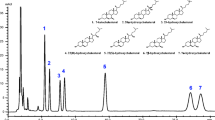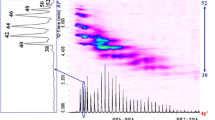Abstract
Commercial fish oils and foods containing fish may contain trans and/or isomerized fatty acids (FA) produced during processing or as part of prepared foods. The current American Oil Chemists’ Society (AOCS) official method for marine oils (method Ce 1i-07) is based on separation by use of poly(ethylene glycol) (PEG) columns, for example Supelcowax-10 or equivalent, which do not resolve most unsaturated FA geometric isomers. Highly polar 100-m cyanopropyl siloxane (CPS) columns, for example SP-2560 and CP Sil 88 are recommended for separation of geometric FA isomers. Complementary separations were achieved by use of two different elution temperature programs with the same CPS column. This study is the first direct comparison of the separations achieved by use of 30-m Supelcowax-10 and 100-m SP-2560 columns for fatty acid methyl esters (FAME) prepared from the same fish oil and fish muscle sample. To simplify the identification of the FA in these fish samples, FA were fractionated on the basis of the number and type of double bonds by silver-ion solid-phase extraction (Ag+-SPE) before GC analysis. The results showed that a combination of the three GC separations was necessary to resolve and identify most of the unsaturated FA, FA isomers, and other components of fish products, for example phytanic and phytenic acids. Equivalent chain length (ECL) values of most FAME in fish were calculated from the separations achieved by use of both GC columns; the values obtained were shown to be consistent with previously reported values for the Supelcowax-10 column. ECL values were also calculated for the FA separated on the SP-2560 column. The calculated ECL values were equally valid under isothermal and temperature-programmed elution GC conditions, and were valuable for confirmation of the identity of several unsaturated FAME in the fish samples. When analyzing commercially prepared fish foods, deodorized marine oils, or foods fortified with marine oils it is strongly recommended that quantitative data acquired by use of PEG columns is complemented with data obtained from separations using highly polar CPS columns.





Similar content being viewed by others
Abbreviations
- CLA:
-
Conjugated linoleic acid
- CPS:
-
Cyanopropyl siloxane
- DHA:
-
Docosahexaenoic acid
- ECL:
-
Equivalent chain length
- EPA:
-
Eicosapentaenoic acid
- FA:
-
Fatty acid
- FAME:
-
Fatty acid methyl ester
- FT-NIR:
-
Fourier transform near infrared
- GC:
-
Gas chromatography
- LC:
-
Long-chain
- MUFA:
-
Monounsaturated fatty acid
- NMI:
-
Non-methylene interrupted
- PEG:
-
Poly(ethylene glycol)
- pha:
-
Phytanic acid
- phe:
-
Phytenic acid
- PUFA:
-
Polyunsaturated fatty acid
- SPE:
-
Solid-phase extraction
References
Barceló-Coblijn G, Murphy EJ (2009) Alpha-linolenic acid and its conversion to longer chain n-3 fatty acids: benefits for human health and a role in maintaining tissue n-3 fatty acid levels. Progr Lipid Res 48:355–374
Degirolamo C, Kelley KL, Wilson MD, Rudel LL (2010) Dietary n-3 LCPUFA from fish oil but not α-linolenic acid-derived LCPUFA confers atheroprotection in mice. J Lipid Res 51:1897–1905
Koletzko B, Lien E, Agostoni C, Böhles H, Campoy C, Cetin I, Decsi T, Dudenhausen JW, Dupont C, Forsyth S, Hoesli I, Holzgreve W, Lapillonne A, Putet G, Secher NJ, Symonds M, Szajewska H, Willatts P, Uauy R (2008) The roles of long-chain polyunsaturated fatty acids in pregnancy, lactation and infancy: review of current knowledge and consensus recommendations. J Perinat Med 36:5–14
Kris-Etherton PM, Hill AM (2008) n-3 Fatty Acids: food or supplements? J Am Diet Assoc 108:1125–1130
AOCS Official Method Ce 1i-07 (2007) Determination of saturated, cis-monounsaturated and cis-polyunsaturated fatty acids in marine and other oils containing long-chain polyunsaturated fatty acids (PUFA) by capillary GLC, AOCS. Urbana, IL
Ackman RG (1967) The chain-length overlap problem in gas-liquid chromatography with polyester liquid phases. Lipids 2:502–505
Kramer JKG, Fouchard RC, Jenkins KJ (1985) Differences in chromatographic properties of fused silica capillary columns, coated, crosslinked, bonded, or crosslinked and bonded with poly(ethylene glycol)s (CARBOWAX 20M) using complex fatty acid methyl ester mixtures. J Chromatogr Sci 23:54–56
Ackman RG (1986) WCOT (capillary) gas–liquid chromatography. In: Hamilton RJ, Rossell JB (eds) Analysis of oils and fats. Elsevier Applied Science Publishers, New York, pp 137–206
Thompson RH (1996) Simplifying fatty acid analyses in multicomponent foods with a standard set of isothermal GLC conditions coupled with ECL determinations. J Chromatogr Sci 34:495–504
Kramer JKG, Blackadar CB, Zhou J (2002). Evaluation of two GC columns (60-m Supelcowax-10 and 100-m CP Sil 88) for analysis of milkfat with emphasis on CLA, 18:1, 18:2 and 18:3 isomers, and short- and long-chain FA. Lipids 37:823–835
Sébédio J-L, Ratanayake WMN, Ackman RG, Prevost J (1993) Stability of polyunsaturated omega-3 fatty acids during deep fat frying of Atlantic mackerel (Scomber scombrus L.). Food Res Int 26:163–172
Kolanowski W, Laufenberg G (2006) Enrichment of food products with polyunsaturated fatty acids by fish oil addition. Eur Food Res Technol 222:472–477
Mjøs SA (2005) Properties of trans isomers of eicosapentaenoic acid and docosahexaenoic acid methyl esters on cyanopropyl stationary phases. J Chromatogr A 1100:185–192
Mjøs SA, Solvang M (2006) Geometrical isomerisation of eicosapentaenoic acid and docosahexaenoic acid at high temperatures. Eur J Lipid Sci Technol 108:589–597
Fournier V, Juanéda P, Destaillats F, Dionisi F, Lambelet P, Sébédio J-L, Berdeaux O (2006) Analysis of eicosapentaenoic and docosahexaenoic acid geometrical isomers formed during fish oil deodorization. J Chromatogr A 1129:21–28
Fournier V, Destaillats F, Juanéda P, Dionisi F, Lambelet P, Sébédio J-L, Berdeaux O (2006) Thermal degradation of long-chain polyunsaturated fatty acids during deodorization of fish oil. Eur J Lipid Sci Technol 108:33–42
Fournier V, Destaillats F, Hug B, Golay P-A, Joffre F, Juanéda P, Sémon E, Dionisi F, Lambelet P, Sébédio J-L, Berdeaux O (2007) Quantification of eicosapentaenoic and docosahexaenoic acid geometrical isomers formed during fish oil deodorization by gas–liquid chromatography. J Chromatogr A 1154:353–359
Golay P-A, Giuffrida F, Dionisi F, Destaillats F (2009) Streamlined methods for the resolution and quantification of fatty acids including trans fatty acid isomers in food products by gas chromatography. J AOAC Int 92:1301–1309
Curtis JM (2007) Analysis of oils and concentrates. In: Breivik H (ed) Long-chain omega-3 specialty oils. The Oily Press, Bridgewater, pp 219–241
Azizian H, Kramer JKG, Ehler S, Curtis JM (2010) Rapid quantitation of fish oil fatty acids and their ethyl esters by FT-NIR models. Eur J Lipid Sci Technol 112:452–462
Precht D, Molkentin J (2003) Overestimation of linoleic acid and trans-C18:2 isomers in milk fats with emphasis on trans Δ9, trans Δ12-octadecadienoic acid. Milchwissenschaft 58:30–34
Ratnayake WMN (2004) Overview of methods for the determination of trans fatty acids by gas chromatography, silver-ion thin-layer chromatography, silver-ion liquid chromatography, and gas chromatography/mass spectrometry. J AOAC Int 87:523–539
Cruz-Hernandez C, Deng Z, Zhou J, Hill AR, Yurawecz MP, Delmonte P, Mossoba MM, Dugan MER, Kramer JKG (2004). Methods for analysis of conjugated linoleic acid and trans-18:1 isomers in dairy fats by using a combination of gas chromatography, silver-ion thin-layer chromatography/gas chromatography, and silver-ion liquid chromatography. J AOAC Int 87:545–562
Kramer JKG, Hernandez M, Cruz-Hernandez C, Kraft J, Dugan MER (2008) Combining results of two GC separations partly achieves determination of all cis and trans 16:1, 18:1, 18:2 and 18:3 except CLA isomers of milk fat as demonstrated using Ag ion SPE fractionation. Lipids 43:259–273
Mjøs SA (2008) Retention behavior of trans isomers of eicosapentaenoic and docosahexaenoic acid methyl esters on a poly(ethylene glycol) stationary phase. Eur J Lipid Sci Technol 110:547–553
Mossoba MM, Moss J, Kramer JKG (2009) Trans fat labeling and levels in US foods: assessment of gas chromatographic and infrared spectroscopic techniques for regulatory compliance. J AOAC Int 92:1284–1300
Bannon CD, Craske JD, Norman LM (1988) Effects of overload of capillary gas-chromatographic columns on the equivalent chain lengths of C18 unsaturated fatty acid methyl esters. J Chromatogr 447:43–52
Christie WW (1988) Equivalent chain-lengths of methyl ester derivatives of fatty acids on gas-liquid chromatography. J Chromatogr 447:305–314
AOCS Official Method Ce 1h-05 (2005) Determination of cis-, trans-, saturated, monounsaturated and polyunsaturated fatty acids in vegetable or non-ruminant animal oils and fats by capillary GLC. AOCS, Champaign
Precht D, Molketin J (1999) C18:1,C18:2 and C18:3 trans and cis fatty acid isomers including conjugated cis Δ9, trans Δ11 linoleic acid (CLA) as well as total fat composition of German human milk lipids. Nahrung 43:233–244
Precht D, Molketin J (2000) Identification and quantitation of cis/trans C16:1 and C17:1 fatty acid positional isomers in German human milk lipids by thin-layer chromatography and gas chromatography/mass spectrometry. Eur J Lipid Sci Technol 102:102–113
Delmonte P, Fardin Kia A-R, Hu Q, Rader JI (2009) Review of methods for preparation and gas chromatographic separation of trans and cis reference fatty acids. J AOAC Int 92:1310–1326
Delmonte P, Fardin Kia A-R, Kramer JKG, Mossoba MM, Sidisky L, Rader JI (2011) Separation characteristics of fatty acid methyl esters using SLB-1L111, a new ionic liquid coated capillary gas chromatographic column. J Chromatogr 1218:545–554
Ackman RG (1989) Fatty acids. In: Ackman RG (ed) Marine biogenic lipids, fats, and oils, vol 1. CRC Press, Boco Raton, pp 103–137
Destaillats F, Wolff RL, Precht D, Molkentin J (2000) Study of individual trans- and cis-16:1 isomers in cow, goat, and ewe cheese fats by gas-chromatography with emphasis on the trans-3 isomer. Lipids 35:1027–1032
Ackman RG (1999) Conjugated linoleic acid (CLA) in lipids of fish tissue. In: Yurawecz MP, Mossoba MM, Kramer JKG, Pariza MW, Nelson GJ (eds) Advances in conjugated linoleic acid research, vol 1. AOCS Press, Champaign, pp 283–295
Jamieson GR (1975) GLC identification techniques for long-chain unsaturated fatty acids. J Chromatogr Sci 13:491–497
Wijesundera RC, Ackman RG (1989) Evaluation of calculation of ECL values for cis and trans isomers of some diethylenic C20 fatty acids: mono- and diethylenic capillary GLC data for the liquid phases SP-2340, Supelcowax-10, and SPB-1. J Chromatogr Sci 27:399–404
Delmonte P, Rader JI (2007) Evaluation of gas chromatographic methods for the determination of trans fat. Anal Bioanal Chem 389:77–85
Mjøs SA, Haugsgjerd BO (2011) Trans fatty acid analyses in samples of marine origin: the risk of false positives. J Agric Food Chem 59:3520–3531
Acknowledgments
The authors thank Drs Roberto Anedda and Carlo Piga for their encouragement and for assistance with extraction of lipids from the fish muscles, and the staff at Porto Conte Ricerche Srl for their assistance with these studies.
Author information
Authors and Affiliations
Corresponding author
About this article
Cite this article
Santercole, V., Delmonte, P. & Kramer, J.K.G. Comparison of Separations of Fatty Acids from Fish Products Using a 30-m Supelcowax-10 and a 100-m SP-2560 Column. Lipids 47, 329–344 (2012). https://doi.org/10.1007/s11745-011-3645-y
Received:
Accepted:
Published:
Issue Date:
DOI: https://doi.org/10.1007/s11745-011-3645-y




